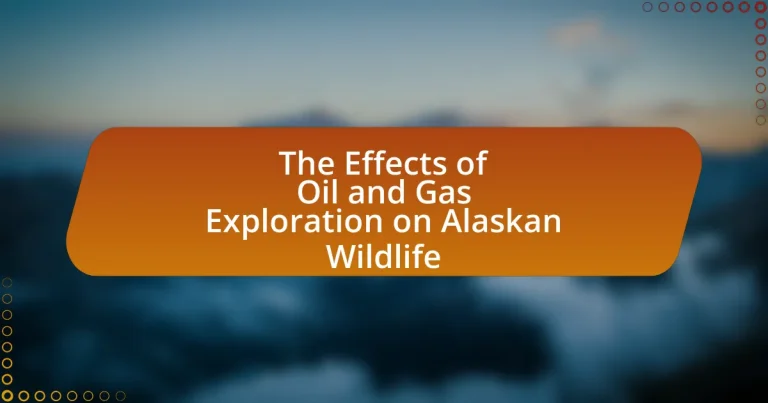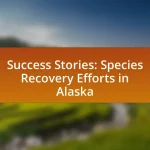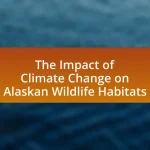The article examines the significant effects of oil and gas exploration on Alaskan wildlife, highlighting habitat disruption, pollution, and altered migration patterns. It details how infrastructure development, such as roads and drilling sites, fragments ecosystems and threatens species like caribou and polar bears. The article also discusses the direct consequences of oil spills on marine and terrestrial wildlife, the impact of noise pollution on animal behavior, and the regulatory measures in place to protect these vulnerable species. Furthermore, it explores mitigation strategies and best practices that can minimize the environmental footprint of exploration activities, emphasizing the importance of collaboration among stakeholders to enhance wildlife protection.
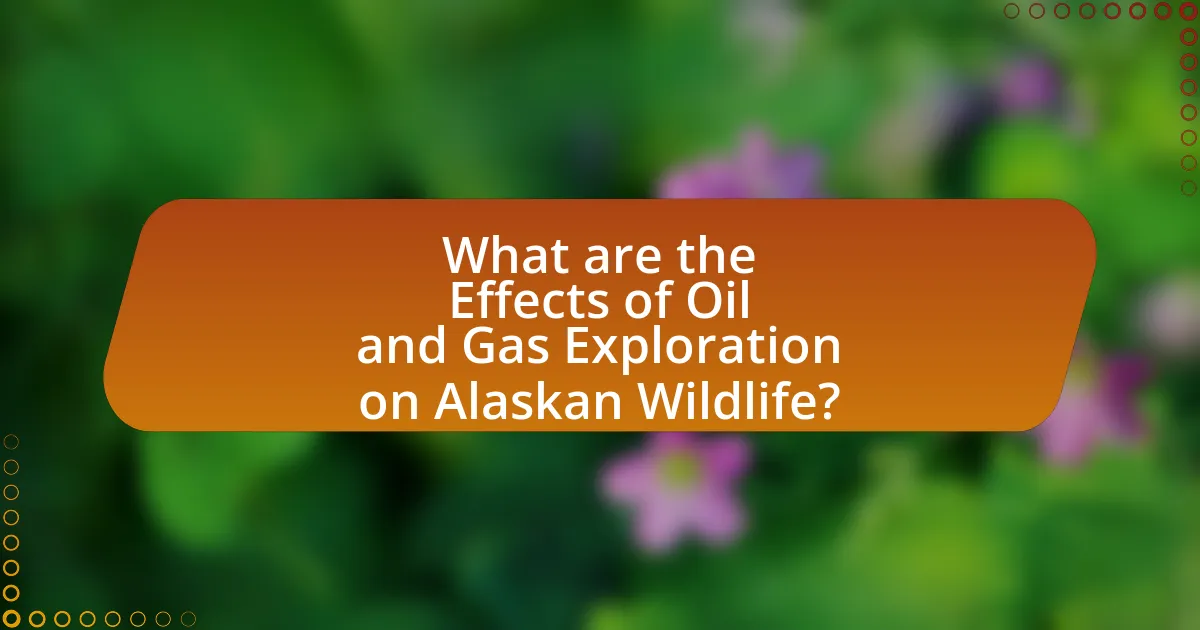
What are the Effects of Oil and Gas Exploration on Alaskan Wildlife?
Oil and gas exploration significantly impacts Alaskan wildlife by disrupting habitats, increasing pollution, and altering migration patterns. The construction of infrastructure, such as roads and drilling sites, fragments ecosystems, making it difficult for species like caribou and polar bears to access their traditional habitats. Additionally, oil spills pose a severe threat to marine and terrestrial wildlife, leading to long-term ecological damage. For instance, the 1989 Exxon Valdez oil spill resulted in the death of thousands of seabirds and marine mammals, highlighting the devastating effects of such exploration activities. Furthermore, increased human activity associated with exploration can lead to stress and behavioral changes in wildlife, further endangering their populations.
How does oil and gas exploration impact the habitats of Alaskan wildlife?
Oil and gas exploration significantly disrupts the habitats of Alaskan wildlife by causing habitat fragmentation, pollution, and increased human activity. The construction of drilling sites, roads, and pipelines leads to the destruction of critical habitats for species such as caribou, polar bears, and migratory birds. For instance, the Arctic National Wildlife Refuge, a vital area for diverse wildlife, faces threats from potential drilling activities that could alter migration patterns and breeding grounds. Additionally, oil spills and leaks can contaminate water sources and soil, adversely affecting the health of local ecosystems. Studies have shown that noise pollution from exploration activities can interfere with the communication and mating behaviors of various species, further exacerbating the impact on wildlife populations.
What specific habitats are most affected by oil and gas activities?
The specific habitats most affected by oil and gas activities include coastal wetlands, tundra ecosystems, and marine environments. Coastal wetlands are particularly vulnerable due to oil spills and habitat disruption from drilling operations, which can lead to loss of biodiversity and degradation of water quality. Tundra ecosystems, characterized by their fragile vegetation and permafrost, face significant impacts from infrastructure development and increased human activity, which can alter the natural landscape and disrupt wildlife migration patterns. Marine environments, especially in areas like the Chukchi and Beaufort Seas, are affected by seismic surveys and potential oil spills, threatening marine species and their habitats. These impacts are documented in studies such as the U.S. Geological Survey’s assessment of oil and gas development effects on Alaskan wildlife, highlighting the critical need for environmental protection in these sensitive areas.
How do changes in habitat affect wildlife populations?
Changes in habitat significantly affect wildlife populations by altering their living conditions, food availability, and breeding sites. For instance, oil and gas exploration in Alaska leads to habitat fragmentation, which disrupts migration patterns and reduces access to essential resources. Research indicates that species such as caribou experience decreased calving success due to disturbances from industrial activities, as highlighted in the study “Impacts of Oil Development on Caribou and Other Wildlife” by the U.S. Geological Survey. This evidence demonstrates that habitat changes directly correlate with declines in wildlife populations, emphasizing the critical need for conservation measures in affected areas.
What are the direct effects of oil spills on Alaskan wildlife?
Oil spills have severe direct effects on Alaskan wildlife, including immediate harm to various species through exposure to toxic substances. Marine mammals, such as seals and sea otters, suffer from hypothermia due to fur contamination, which compromises their insulation. Birds experience feather damage, leading to loss of buoyancy and insulation, resulting in hypothermia and increased mortality rates. Additionally, fish populations face reproductive issues and developmental abnormalities due to exposure to oil toxins. Studies have shown that oil spills can lead to long-term population declines in affected species, as evidenced by the 1989 Exxon Valdez oil spill, which resulted in significant declines in local wildlife populations for decades.
Which species are most vulnerable to oil spills?
Marine mammals, seabirds, and certain fish species are most vulnerable to oil spills. Specifically, species such as sea otters, harbor seals, and various seabirds like the common murre are highly susceptible due to their reliance on clean water and healthy ecosystems for survival. For instance, sea otters are particularly affected because their fur is crucial for insulation; oil contamination can lead to hypothermia. Additionally, fish species like salmon and herring are vulnerable during their spawning cycles, as oil can disrupt their reproductive processes and lead to long-term population declines. Studies have shown that oil spills can cause significant mortality rates and reproductive failures in these species, highlighting their vulnerability in affected ecosystems.
What are the long-term consequences of oil spills on wildlife health?
Oil spills have severe long-term consequences on wildlife health, including chronic toxicity, reproductive issues, and habitat degradation. For instance, studies have shown that exposure to oil can lead to long-lasting effects on the immune system of marine mammals, such as seals and sea otters, making them more susceptible to diseases. Additionally, birds exposed to oil often experience reduced reproductive success, as seen in the aftermath of the Exxon Valdez spill, where populations of affected species took decades to recover. Furthermore, oil spills can disrupt food chains, leading to declines in fish populations, which in turn affects predators reliant on those fish for sustenance. These impacts illustrate the profound and enduring harm oil spills inflict on wildlife health and ecosystems.
How does noise pollution from exploration affect wildlife behavior?
Noise pollution from exploration significantly disrupts wildlife behavior by causing stress and altering communication patterns among species. For instance, marine mammals like whales and seals rely on sound for navigation and social interactions; increased noise levels from exploration activities can lead to disorientation, reduced foraging success, and changes in migration routes. Research conducted by the National Oceanic and Atmospheric Administration (NOAA) indicates that exposure to loud underwater sounds can result in temporary or permanent hearing loss in marine species, further impacting their ability to thrive in their natural habitats. Additionally, terrestrial animals, such as caribou, exhibit altered movement patterns and increased anxiety in response to noise, which can affect their reproductive success and overall population dynamics.
What types of wildlife are most sensitive to noise pollution?
Marine mammals, particularly whales and seals, are the types of wildlife most sensitive to noise pollution. Research indicates that these species rely heavily on sound for communication, navigation, and foraging. For example, studies have shown that increased underwater noise from oil and gas exploration can disrupt their vocalizations and lead to disorientation, affecting their ability to find food and mates. Additionally, terrestrial species such as caribou are also impacted, as noise pollution can alter their migration patterns and stress levels, ultimately affecting their survival.
How does noise pollution disrupt mating and feeding patterns?
Noise pollution disrupts mating and feeding patterns by interfering with the communication signals that animals rely on for these behaviors. For instance, many species use vocalizations to attract mates or locate food, and elevated noise levels can mask these sounds, leading to decreased mating success and foraging efficiency. Research has shown that marine mammals, such as whales, experience significant disruptions in their communication due to noise from oil and gas exploration activities, which can result in reduced reproductive rates and altered feeding habits. Specifically, studies indicate that increased underwater noise can lead to changes in the distribution and behavior of these animals, ultimately affecting their survival and population dynamics.
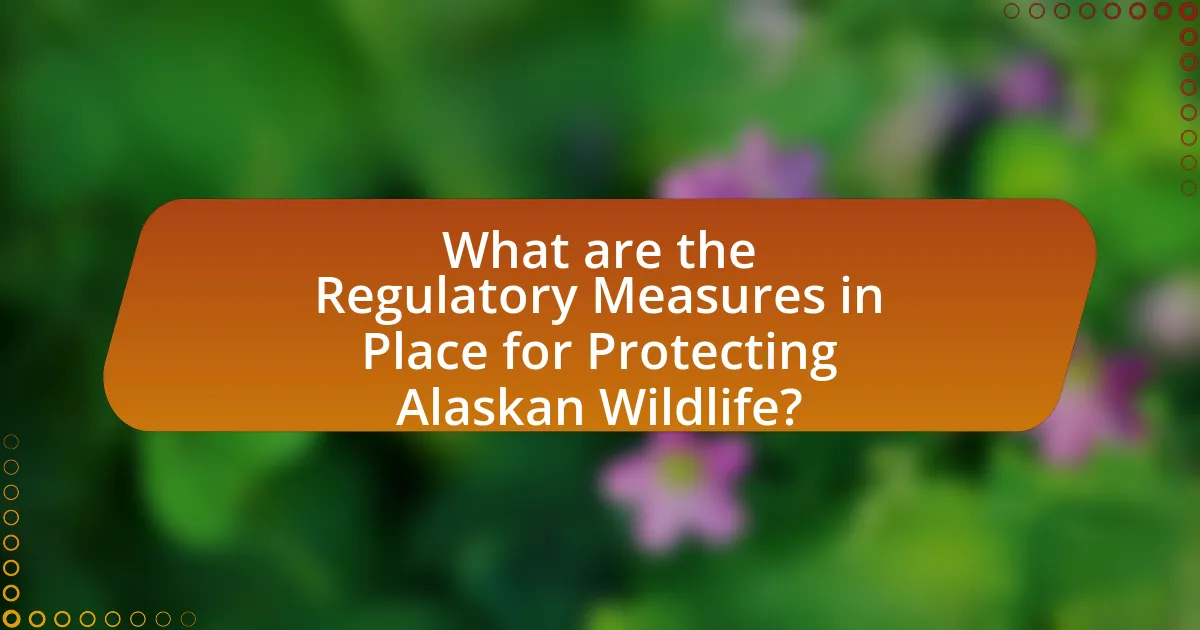
What are the Regulatory Measures in Place for Protecting Alaskan Wildlife?
Regulatory measures for protecting Alaskan wildlife include the Endangered Species Act, the Marine Mammal Protection Act, and various state-level regulations. The Endangered Species Act provides a framework for the conservation of species at risk of extinction, while the Marine Mammal Protection Act prohibits the harassment, hunting, and killing of marine mammals, ensuring their populations are sustained. Additionally, the Alaska National Interest Lands Conservation Act designates protected areas and wildlife refuges, further safeguarding habitats. These regulations are enforced by agencies such as the U.S. Fish and Wildlife Service and the Alaska Department of Fish and Game, which monitor compliance and assess the impacts of activities like oil and gas exploration on wildlife populations.
What laws govern oil and gas exploration in Alaska?
The laws governing oil and gas exploration in Alaska include the Alaska Oil and Gas Conservation Act, the Alaska Native Claims Settlement Act, and the National Environmental Policy Act. The Alaska Oil and Gas Conservation Act regulates the exploration and production of oil and gas resources to ensure efficient recovery and prevent waste. The Alaska Native Claims Settlement Act addresses land ownership and rights of Native Alaskans, impacting exploration activities on their lands. The National Environmental Policy Act mandates environmental assessments for federal projects, including oil and gas exploration, to evaluate potential impacts on wildlife and habitats. These laws collectively shape the regulatory framework for oil and gas activities in Alaska, balancing resource development with environmental protection.
How effective are these laws in protecting wildlife?
The effectiveness of laws protecting wildlife in the context of oil and gas exploration in Alaska is limited. While regulations such as the Endangered Species Act and the Marine Mammal Protection Act aim to safeguard wildlife, enforcement challenges and loopholes often undermine their impact. For instance, studies indicate that oil spills and habitat disruption from exploration activities have led to significant declines in populations of species like the polar bear and the bowhead whale, despite existing protections. Additionally, the U.S. Fish and Wildlife Service reported that habitat loss due to industrial activities continues to threaten biodiversity in the region, highlighting the inadequacy of current laws in fully mitigating the adverse effects of oil and gas exploration on wildlife.
What agencies are responsible for enforcing these regulations?
The agencies responsible for enforcing regulations related to oil and gas exploration and its effects on Alaskan wildlife include the Bureau of Land Management (BLM), the Environmental Protection Agency (EPA), and the U.S. Fish and Wildlife Service (USFWS). The BLM manages public lands and oversees oil and gas leasing, while the EPA enforces environmental standards to protect air and water quality. The USFWS is tasked with protecting wildlife and their habitats, ensuring compliance with the Endangered Species Act. These agencies collaborate to ensure that exploration activities adhere to environmental regulations and mitigate impacts on wildlife.
How do environmental assessments influence exploration activities?
Environmental assessments significantly influence exploration activities by identifying potential environmental impacts and ensuring compliance with regulations. These assessments evaluate the effects of proposed exploration projects on ecosystems, wildlife, and natural resources, which can lead to modifications in project plans or even project cancellations. For instance, in Alaska, the National Environmental Policy Act mandates thorough assessments for oil and gas exploration, which have resulted in changes to drilling locations and operational practices to minimize harm to sensitive wildlife habitats. This regulatory framework ensures that exploration activities are conducted responsibly, balancing economic interests with environmental protection.
What factors are considered in environmental assessments?
Environmental assessments consider several key factors, including ecological impacts, socio-economic effects, and regulatory compliance. Ecological impacts involve the assessment of wildlife habitats, biodiversity, and ecosystem health, particularly in sensitive areas like Alaska, where oil and gas exploration can disrupt local species and their environments. Socio-economic effects evaluate how projects may influence local communities, including potential job creation or loss, changes in land use, and effects on traditional practices. Regulatory compliance ensures that projects adhere to environmental laws and guidelines, which are crucial for protecting both wildlife and human interests in the region. These factors collectively inform decision-making processes to mitigate adverse effects on Alaskan wildlife during oil and gas exploration.
How do assessments impact decision-making in exploration projects?
Assessments significantly influence decision-making in exploration projects by providing critical data on environmental impacts, resource availability, and regulatory compliance. These evaluations help stakeholders understand the potential consequences of exploration activities on ecosystems, particularly in sensitive areas like Alaska, where wildlife is vulnerable. For instance, environmental impact assessments (EIAs) are mandated by law in many jurisdictions, ensuring that potential harm to species such as polar bears and migratory birds is thoroughly analyzed before project approval. This data-driven approach allows decision-makers to weigh the economic benefits of exploration against ecological risks, leading to more informed and responsible choices.

What Mitigation Strategies Can Minimize the Impact of Oil and Gas Exploration on Wildlife?
Mitigation strategies that can minimize the impact of oil and gas exploration on wildlife include implementing buffer zones, conducting environmental impact assessments, and utilizing advanced technology for monitoring. Buffer zones around sensitive habitats reduce disturbances from exploration activities, thereby protecting wildlife. Environmental impact assessments, mandated by regulations, help identify potential risks and inform decision-making to minimize harm. Additionally, advanced technologies such as remote sensing and drone surveillance enable real-time monitoring of wildlife populations and habitats, allowing for timely interventions when necessary. These strategies collectively contribute to reducing the negative effects of oil and gas exploration on wildlife in Alaskan ecosystems.
What best practices can be implemented during exploration to protect wildlife?
Implementing best practices during exploration to protect wildlife includes establishing buffer zones, minimizing habitat disturbance, and utilizing technology for monitoring. Buffer zones around sensitive habitats reduce direct impacts on wildlife, as evidenced by studies showing that maintaining a distance of at least 500 meters from nesting sites can significantly decrease disturbance to bird populations. Minimizing habitat disturbance through careful planning and timing of exploration activities, such as avoiding critical breeding seasons, has been shown to enhance wildlife survival rates. Additionally, employing remote sensing and drone technology for monitoring wildlife movements allows for real-time data collection, enabling timely adjustments to exploration activities to mitigate potential harm. These practices collectively contribute to the conservation of wildlife during oil and gas exploration in Alaska.
How can technology reduce the environmental footprint of exploration?
Technology can reduce the environmental footprint of exploration by enabling more efficient resource extraction and minimizing habitat disruption. Advanced techniques such as remote sensing and drone technology allow for precise mapping of exploration sites, which reduces the need for extensive land clearing. Additionally, innovations in drilling technology, such as horizontal drilling and hydraulic fracturing, enable access to resources with a smaller surface footprint. According to a study by the U.S. Geological Survey, these methods can decrease the overall land disturbance by up to 90% compared to traditional drilling methods. Furthermore, real-time monitoring systems can track environmental impacts, allowing for immediate corrective actions to mitigate harm to wildlife and ecosystems.
What role do wildlife corridors play in mitigating impacts?
Wildlife corridors play a crucial role in mitigating the impacts of habitat fragmentation caused by oil and gas exploration. These corridors facilitate the movement of wildlife between isolated habitats, allowing for genetic exchange and reducing the risk of inbreeding. Research indicates that wildlife corridors can enhance species survival rates by providing safe passage across human-altered landscapes, which is particularly important in regions like Alaska where oil and gas activities disrupt natural habitats. For example, studies have shown that the establishment of corridors can lead to a 30% increase in the population viability of certain species affected by industrial development.
How can stakeholders collaborate to enhance wildlife protection?
Stakeholders can collaborate to enhance wildlife protection by forming partnerships that integrate conservation efforts, regulatory compliance, and community engagement. For instance, oil and gas companies can work with environmental organizations to develop best practices that minimize habitat disruption during exploration activities. Research indicates that collaborative frameworks, such as the Alaska Wildlife Conservation Center’s partnerships with industry and government, have led to improved wildlife management strategies and reduced negative impacts on ecosystems. Additionally, involving local communities in decision-making processes fosters a sense of stewardship and ensures that traditional ecological knowledge informs conservation practices.
What partnerships exist between industry and conservation groups?
Partnerships between the oil and gas industry and conservation groups often focus on collaborative efforts to mitigate environmental impacts while promoting sustainable practices. For instance, the Alaska Oil and Gas Association collaborates with organizations like the World Wildlife Fund to develop best practices for wildlife protection during exploration activities. These partnerships aim to balance economic interests with ecological preservation, as evidenced by initiatives that include habitat restoration projects and research funding to monitor wildlife populations affected by industry operations. Such collaborations demonstrate a commitment to responsible resource management while addressing conservation goals.
How can local communities contribute to wildlife protection efforts?
Local communities can contribute to wildlife protection efforts by actively participating in conservation initiatives and advocating for sustainable practices. For instance, community-led programs in Alaska have successfully engaged residents in monitoring wildlife populations and habitats, which helps gather essential data for conservation strategies. Additionally, local communities can influence policy by voicing concerns about the impacts of oil and gas exploration on wildlife, as seen in the efforts of organizations like the Alaska Wilderness League, which mobilizes community support to protect critical habitats. These actions not only enhance local stewardship of wildlife but also foster a collaborative approach to conservation that can mitigate the adverse effects of industrial activities.
What are the most effective ways to monitor wildlife populations during exploration?
The most effective ways to monitor wildlife populations during exploration include the use of remote sensing technologies, camera traps, and aerial surveys. Remote sensing technologies, such as satellite imagery and drones, allow for large-scale habitat assessment and population tracking without disturbing wildlife. Camera traps provide continuous monitoring of animal activity and behavior, enabling researchers to gather data on species presence and population density. Aerial surveys, conducted via helicopters or fixed-wing aircraft, offer a comprehensive view of wildlife distribution and abundance across vast areas, particularly in remote Alaskan landscapes. These methods have been validated by studies showing their effectiveness in accurately assessing wildlife populations in challenging environments, such as the research conducted by the U.S. Geological Survey, which highlights the successful application of these techniques in monitoring caribou and other species in Alaska.
What technologies are used for wildlife monitoring in exploration areas?
Technologies used for wildlife monitoring in exploration areas include GPS tracking, remote sensing, camera traps, and acoustic monitoring. GPS tracking allows researchers to gather precise location data on animal movements, which is crucial for understanding habitat use and migration patterns. Remote sensing employs satellite imagery and aerial surveys to assess habitat changes and animal populations over large areas. Camera traps provide visual evidence of wildlife presence and behavior, enabling researchers to monitor species without human interference. Acoustic monitoring captures sounds from wildlife, aiding in the identification of species and their activities. These technologies collectively enhance the understanding of wildlife dynamics in regions affected by oil and gas exploration, ensuring informed conservation efforts.
How can data from monitoring inform future exploration practices?
Data from monitoring can inform future exploration practices by providing insights into the ecological impacts of oil and gas activities on Alaskan wildlife. For instance, monitoring data can reveal patterns of animal behavior, population dynamics, and habitat use in response to exploration activities. This information allows companies and regulators to adapt exploration techniques to minimize disturbances, such as adjusting drilling schedules to avoid critical wildlife periods, as evidenced by studies showing reduced stress in caribou populations when exploration activities are timed to avoid calving seasons. Additionally, continuous monitoring can help identify areas of high ecological sensitivity, guiding decision-making to protect vulnerable species and habitats, thereby ensuring sustainable exploration practices.
